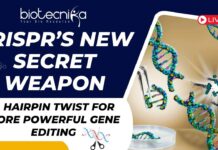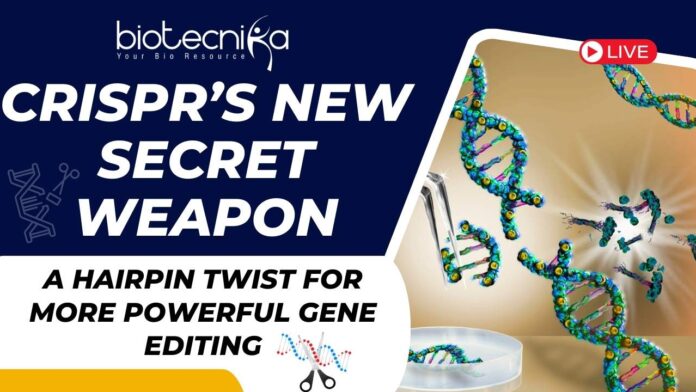CRISPR’s New Secret Weapon: A Hairpin Twist for More Powerful Gene Editing
From the UC Berkeley labs to the future of gene therapy, researchers have added a clever twist to CRISPR-Cas9. This one could change the way genetic diseases are treated forever.
In the world of gene editing, one tweak in the gene can spell the difference between a cure and a failed experiment. A team of researchers from the Innovative Genomics Institute (IGI) at the University of California, Berkeley, proposed something unexpected. They have taken an important yet overlooked component of the CRISPR-Cas9 editing system and upgraded it to a level beyond one’s imagination.
This has led them to a gene editing tool that’s smarter, sharper, and way more efficient, especially in therapeutic use for human immune cells.
The heart of this breakthrough is “Hairpin Internal Nuclear Localization Signal Sequences,” or hiNLS. This may sound complicated. But this small change could lead to a big improvement. This will change the treatment process with the help of CRISPR.
Under the leadership of molecular biology expert Dr. Ross Wilson, a study was published in The CRISPR Journal, April 2025 edition. The study revealed that their hiNLS-enhanced Cas9 Enzyme variants exceeded the current industry standard. This newly constructed enzyme shows an improvement in editing efficiency. It has outperformed in tricky primary human T cells that are difficult to work with.
Why is this experiment important? This is due to the fact that immune cells, especially T cells, are used by the researchers to reprogram them as a treatment option. These cells can be used for cancer, autoimmune disorders, and even the treatment of viral infections.
In gene editing, it’s all about getting to the nucleus fast. This tiny nucleus holds the DNA. With the help of CRISPR, the desired changes can be made in the DNA.
But there’s a problem. The CRISPR-Cas9 enzyme, when delivered as a ribonucleoprotein (RNP) complex, a popular delivery form for clinical applications, doesn’t stick around for long. It has a half-life of just 1 to 2 days. If it doesn’t find its way to the cell’s nucleus quickly, it gets degraded. Game over.
To help Cas9 find the nucleus, researchers have traditionally added special tags called nuclear localization signals (NLS). These tags act like VIP passes, directing the enzyme into the nucleus. Most systems stick these tags onto the ends of the Cas9 protein.
But Dr. Wilson’s team saw an opportunity to rethink the architecture.
Instead of tacking the NLS onto the protein’s tail, Wilson’s team embedded them inside the Cas9 backbone using a structure known as a “hairpin.” The result? A tighter, more efficient shuttle into the nucleus that doesn’t bog down the protein’s function.
It’s like switching from a rickety stairwell to a high-speed elevator.
The researchers tested these hiNLS Cas9 variants using two different RNP delivery techniques: electroporation (think of it as zapping the cells open) and a newer, non-invasive method using peptide tags. Both methods showed a significant bump in gene editing power when paired with hiNLS Cas9.
Even more impressive, they tested the technology on genes like beta-2-microglobulin (B2M) and T cell receptor alpha chain (TRAC), major players in immune system signaling and function, and achieved significantly higher knockout rates than traditional methods.
Of course, a cool lab trick is only half the battle. If a breakthrough can’t be produced at scale, it’s unlikely to ever make it into a clinic. Thankfully, Wilson’s team has that part covered too.
Their hiNLS Cas9 constructs can be manufactured at high purity and yield, making them well-suited for the rigors of pharmaceutical production. That’s a key advantage, especially in a field racing to bring CRISPR therapies to patients.
“Efficient CRISPR enzyme production is essential for translation,” Dr. Wilson explained. “This is one element that allowed the rapid clinical evaluation of Casgevy, the world’s first genome editing drug. Unfortunately, this aspect tends to be overlooked in the basic research performed in academia.”
That’s where their study fills a critical gap.
The strategy didn’t come out of thin air. The work builds on foundational research from CRISPR pioneer and Nobel Prize winner Dr. Jennifer Doudna, also based at IGI. Her earlier studies showed that increasing the density of NLS tags can help Cas9 deliver itself into cells more effectively.
Wilson’s team took that insight and ran with it literally threading it through the backbone of Cas9 to create a self-improving, nucleus-homing molecular tool.
Now, they’re taking things a step further by investigating whether these hiNLS-enhanced versions can self-deliver even better than expected. If that proves true, the technology could reduce the need for delivery carriers like viruses or nanoparticles making therapies safer, cheaper, and faster.
So what’s next for the hiNLS Cas9? The UC Berkeley team is now evaluating its performance across a range of cell types and delivery methods. Their early results are promising, and the implications are huge: from engineering smarter CAR-T cells to treating rare genetic disorders with minimal off-target effects.
With the demand for efficient, safe, and scalable gene editing tools rising fast, this hairpin upgrade could be the missing puzzle piece.
“We’re optimistic that these constructs can help unlock new clinical applications,” said Wilson. “It’s a small structural tweak but it has the potential for a big therapeutic impact.”
In the race to translate gene editing from theory to therapy, details matter. And sometimes, the smallest changes like where you place a molecular tag can have the biggest ripple effects.
With their cleverly engineered hiNLS sequences, the UC Berkeley team has added a powerful new tool to the CRISPR toolbox. And in doing so, they’ve reminded us that innovation doesn’t always mean reinventing the wheel. Sometimes, it’s about looking at the wheel a little differently and adding a hairpin.



























